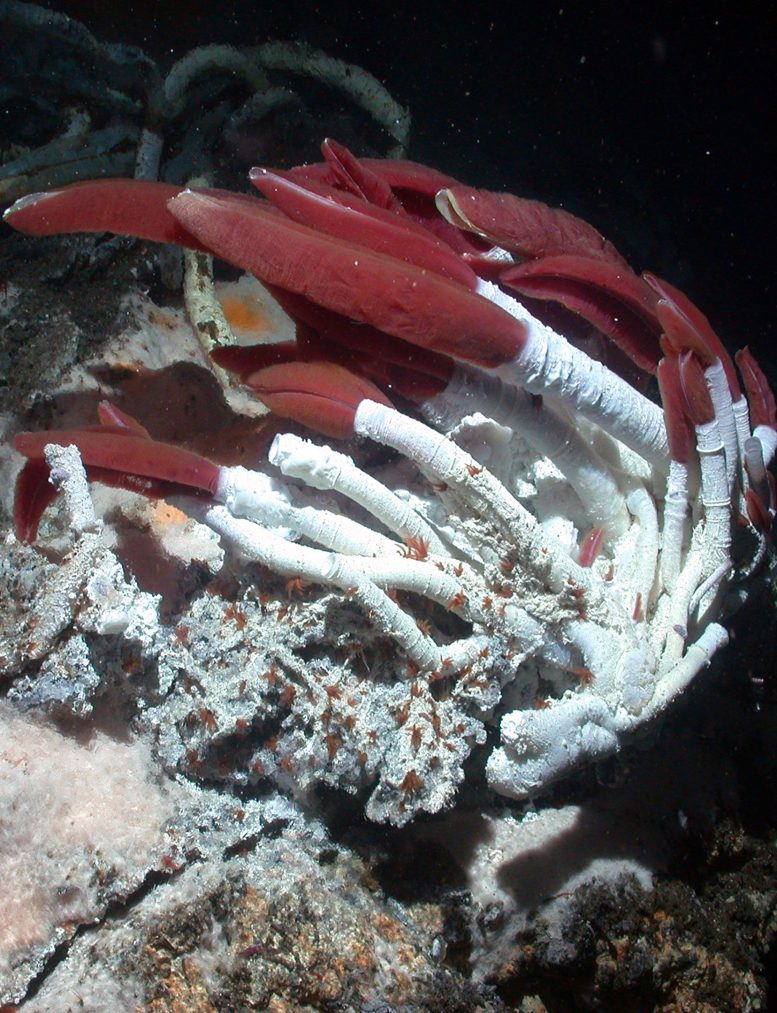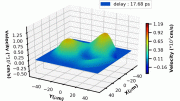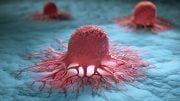Research on the deep-sea vent tubeworm Riftia pachyptila shows how its symbiotic bacteria use two carbon fixation pathways to adapt to deep-sea conditions, suggesting potential for biotechnological applications in carbon capture.
The giant hydrothermal vent tubeworm Riftia pachyptila lives in the harsh deep-sea environment of the East Pacific Rise, where sunlight does not penetrate and the surroundings are known for their extreme temperatures, skull-crushing pressures, and toxic compounds. Growing up to 6 feet tall with a deep-red plume, Riftia does not have a digestive system but thrives off its symbiotic relationship with bacteria that live deep within its body. These billions of bacteria fix carbon dioxide to sugars to sustain themselves and the tubeworm.
While most autotrophic organisms sustain themselves by using a single carbon fixation pathway, Riftia’s chemoautotrophic endosymbionts possess two functional carbon fixation pathways: the Calvin-Benson–Bassham (CBB) and the reductive tricarboxylic acid (rTCA) cycles. Much about these pathways has been a mystery to scientists, who have had a limited understanding of their activities and integrations with other metabolic processes.
Research Discoveries on Carbon Fixation Pathways
Researchers from Harvard’s Department of Organismic and Evolutionary Biology have uncovered new insights into the coordination of these two pathways, revealing a sophisticated adaptation that allows these symbionts to thrive in harsh hydrothermal vent conditions.
In their study, recently published in Nature Microbiology, the researchers collected tubeworms from the East Pacific Rise to study the regulation and coordination of the two functional pathways. By incubating the tubeworms under conditions mimicking their natural environment – including 3,000 PSI pressure and near-toxic levels of sulfur – the researchers were able to measure net carbon fixation rates and examine transcriptional and metabolic responses.
“This paper is really a tour de force of going from studying living organisms and measuring their metabolic rates and allying them directly to transcripts in a way that allowed the research team to show that the pathways are very likely being run in parallel,” said senior co-author Peter Girguis, professor of Organismic and Evolutionary Biology. “The paper shows that the dual pathways are biased by the environmental conditions, and that there are other metabolic systems in orbit around each of these two.”
The research was conducted by members of Girguis’ lab, including Mitchell and Jennifer Delaney, as well as Adam Freedman of the Harvard Informatics Group.
Network Analysis and Metabolic Insights
Carbon fixation is the process of converting carbon dioxide to sugars, and it is the primary process that keeps our biosphere running. Depending on the environment, including available energy and carbon sources, organisms have evolved different metabolic strategies. Photosynthetic organisms, like plants, use sunlight to provide the energy to convert carbon dioxide and water into glucose and oxygen. In the deep sea, beyond the reach of sunlight but where volcanically superheated water is gushing through hydrothermal vents, Riftia pachyptila’s chemoautotrophic symbionts use energy from hydrogen sulfide to fix carbon that fuels the metabolism and growth of the worms. By carefully varying experimental conditions for Riftia, the team was able to identify how environmental changes in chemistry influence how their two carbon pathways are coordinated.
“This is the most in-depth analysis of a bacteria that has two carbon fixation pathways, the rTCA and CBB,” said lead author and postdoctoral scholar Jessica Mitchell. “This is also the first network analysis done on a hydrothermal vent symbiosis and the first network analysis done on a dual carbon fixation pathway system.”
Network analysis enabled the team to spot patterns in the gene expression data and to provide a bigger picture of the system. The analysis identified metabolic hub genes that play a pivotal role in maintaining and regulating the complex network of metabolic reactions within cells.
Distinctive Roles in Metabolic Function
The team found that the transcriptional patterns of the rTCA and CBB cycles varied significantly in response to different geochemical regimes. Each pathway was found to be allied with specific metabolic processes. The rTCA cycle is linked with hydrogenases and dissimilatory nitrate reduction. These enzymes are crucial for processing hydrogen and nitrates in the absence of oxygen, suggesting that the rTCA cycle plays a key role under lower-energy conditions.
In contrast, the CBB cycle is associated with sulfide oxidation and assimilatory nitrate reduction. Sulfide oxidation is a vital process in the chemically rich environment of hydrothermal vents, where sulfides are abundant. By linking the CBB cycle to sulfide oxidation, the symbionts can effectively utilize the chemical energy available in their environment to fix carbon.
Complementary Pathways and Environmental Adaptations
One of the most intriguing findings of the study was the complementary nature of these two pathways. The rTCA cycle appears to be particularly important under conditions where sulfide and oxygen are limited. This was highlighted by the identification of a Group 1e-hydrogenase, which, along with the rTCA cycle, plays a crucial role in the physiological response to such limitations. This flexibility confers a significant advantage, enabling the tubeworms to thrive in the highly variable conditions of hydrothermal vents.
The net carbon fixation rates measured during the study were exceptionally high, which enabled the rapid growth and survival of Riftia pachyptila in their environment. The dual pathways of carbon fixation – each optimized for different environmental conditions – may allow the symbionts to maintain metabolic stability during environmental shifts.
Implications and Future Research
The analysis of these dual carbon fixation pathways and their coordinated regulation in Riftia opens new avenues for research in biological carbon capture as well as basic biochemistry. This knowledge could have practical applications in biotechnology, where the principles of these pathways might be harnessed to develop more efficient systems for carbon fixation. Moreover, understanding how these pathways are regulated could provide insights into the evolution of metabolic diversity and adaptation in extreme environments.
“This study really paves the way for future studies, and understanding how these dual pathways are enabling this organism to fix this amount of carbon,” Mitchell said.
Reference: “Co-expression analysis reveals distinct alliances around two carbon fixation pathways in hydrothermal vent symbionts” by Jessica H. Mitchell, Adam H. Freedman, Jennifer A. Delaney and Peter R. Girguis, 5 June 2024, Nature Microbiology.
DOI: 10.1038/s41564-024-01704-y










Be the first to comment on "Harvard Scientists Reveal Amazing Survival Strategies of Giant Deep-Sea Vent Tubeworm"